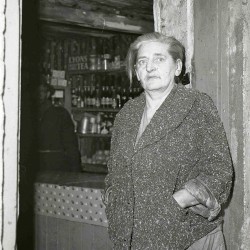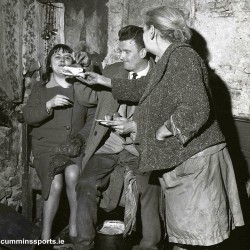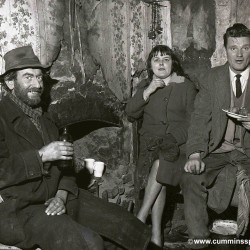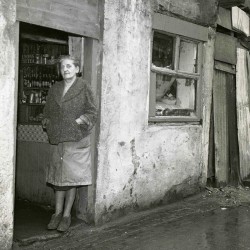
Cathy Barry
“Cathy Barry sells crubeens,
Fairly burstin’ at the seams.
“Here’s up ‘em all”, says the Boys of Fairhill”
What possessed me to skive off from school on a mid-week afternoon and turn up at Cathy Barry’s sheebeen with my camera, I simply don’t know. Curiousity? Maybe. Excitement? Possibly. A rush of blood to the head? Most definitely!
The year was 1964, I was seventeen years old and all I really knew about Cathy Barry was that she was an archetypical Cork character, honoured in song and in story and, unlike the Bould Teddy Quill, the Wild Colonial Boy or Master McGrath, she was still alive – an important consideration if I was to take her photograph!
Chríost Rí Geography teacher, John O’Shea –of Everyman fame – whose class discussions ranged far and wide and on this particular day hit on Cork Characters, had aroused my curiosity. Who was this woman that ran a sheebeen in the centre of Cork city? Across the road from the Bridewell Garda station? Serving crubeens and porter to the merchant princes of Cork city after hours? I was fascinated – and hooked.
The excitement of ‘going on the lang’ from school was now wearing thin
With my camera hidden under my coat, I struck off from Capwell while the school was on lunch-break and headed down Southern Road, along Douglas Street and over Parnell Bridge to the City proper. The excitement of ‘going on the lang’ from school was now wearing thin as I made my way across town to Corn Market Street, known locally as the Coal Quay*. I was now most definitely out of my comfort zone. A sheebeen! I might never be heard of again!
The day’s work was over for the traders on Corn Market St. and they were busy bustling around their open-air stalls clearing up the rubbish of the day. I picked out the kindest looking trader, like the rest complete with black shawl draped around her shoulders, and heart in mouth inquired after Cathy Barry’s. “Over there, boy, under the arch, three doors down”
The archway threw a shadow across the entrance and, viewed from the Coal Quay, the lane looked black and forbidding. My stomach churning, I stepped into the laneway and was surprised to find it wasn’t so dark after all. The first two doorways were roughly blocked-off with rusty galvanized sheeting, then a small window and, just beyond, a woman standing at an open door.
“Cathy Barry, I presume?” I most definitely didn’t say – but I had reached the source of my particular Nile. Red with embarrassment and confusion I splurted out who I was and why I had come. Without saying a word she stepped back and ushered me in the door ahead of her. It was like stepping on to the set of a John B. Keane play! There was no electricity, just a few candles in empty milk-bottles throwing shadows about the place. An earthen floor with bits and pieces of furniture scattered around and an open fireplace, choked with the remnants of many fires long forgotten, but the evidence of which was burned into the scorched wallpaper and sooty plaster above it.
Had the Bull McCabe himself emerged from the gloom I wouldn’t have been surprised
Had the Bull McCabe himself emerged from the gloom I wouldn’t have been surprised. Instead, when my eyes got used to the darkness, I could make out a handful of people in various nooks and crannies drinking from beer bottles and eating boiled potatoes in their skins. It certainly wasn’t Ballymaloe, nor were the customers among the city’s merchant princes. In fact, I got the distinct impression that the clientele were very much down on their luck.
Cathy announced me as, “A young fella that wants to take a few pictures” and everybody readily perked themselves up for the camera. I found it difficult to operate in the gloom as I couldn’t focus the camera accurately nor could I read the scale on the flashgun in the dark. On the other hand, I had no difficulty in getting subjects to pose for photographs. I even got Cathy herself handing out her ‘dish of the day’ to eager customers.
In her youth, people say, Cathy was a handsome woman. Madeline O’Higgins, writing in “The Archive”, a publication of the Northside Folklore Project, says, “I remember Kathy Barry. Oh Lord help us, and a beautiful woman she was, with a lovely black shawl on her! If there was a hurling match coming to Cork, she’d put on a load of crubeens in a big pot, and the best feed they’d ever have was Kathy Barry’s crubeens.” (Boiled pig’s feet, if you must know)
However, the woman before me now was well past middle-age and the years had taken their toll. While she had met me courtesly and allowed me photograph inside her premises, I could sense that now she wanted to see the back of me so I gathered up my bits and pieces and got ready to say my good-byes. To tell you the truth, I was glad to get out of there. I had a distinctly uneasy feeling from the moment I entered. What with the flickering shadows thrown by the few candles, the voices from the dark corners and the hovering presence of Cathy herself, all un-nerved me and I was glad to get out into the daylight once again.
Cathy Barry’s memory lives on only in the songs we sing on the way home from matches
All that happened over fifty years ago and today Cathy Barry’s memory lives on only in the songs we sing on the way home from matches in Thurles & Killarney. Every day I pass the archway to the laneway – or Dalton’s Avenue, to give it it’s official title – where Cathy once reigned. Con Dennehy’s Bar stands proudly at the archway now. The open-air stalls have but a token presence on the Coal Quay now and, every Saturday, the Farmers’ Market brings artisan cheeses, organic vegetables and sweet and sour spare ribs to a discerning clientele yards from Cathy’s front door. There’s surely room for a crubeen and a plate of spuds there somewhere?
“Connie Doyle and Cathy Barry
Took a side-car out to Blarney
On the night the goat broke loose on Grand Parade”
(Connie Doyle owned the famous foxhound, Armoured Car, but that’s another story)
*Pronounced ‘Coal Kay’





Comments are closed.